The Very Best Meat Thermometers, According to Our Tests
Dotdash Meredith and Yahoo Inc. may earn commission or revenue on some items through the links below.
Our picks for the best instant-read, probe, and grill thermometers.
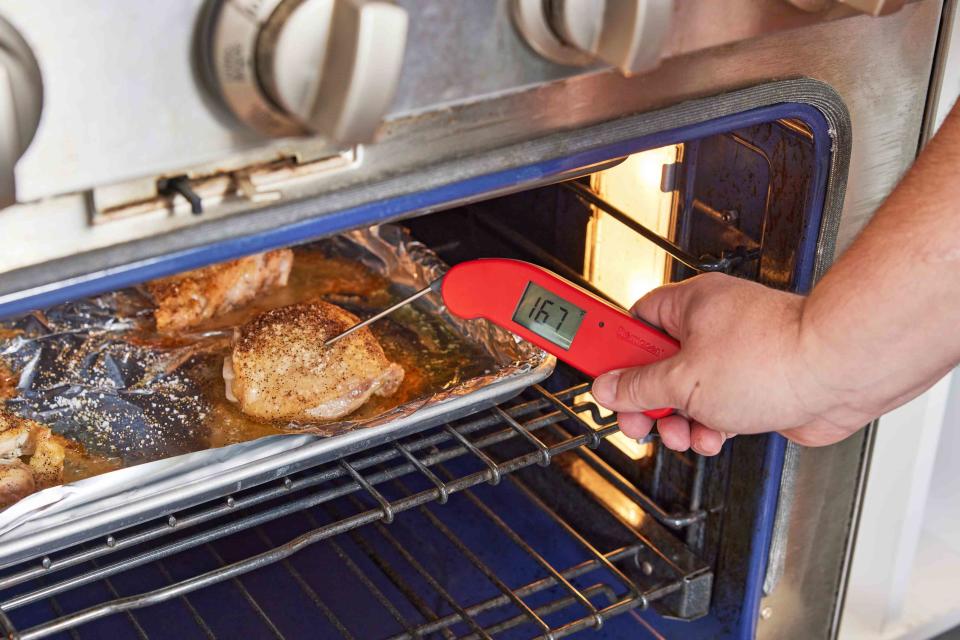
Serious Eats / Russell Kilgore
Straight to the Point
Our favorite instant-read thermometer is the Thermapen ONE, while our budget-friendly recommendation is the ThermoWorks ThermoPop 2. For roasts and deep-frying, we recommend a leave-in probe thermometer like the ThermoWorks ChefAlarm or Polder Digital Leave-In Probe Meat Thermometer. And for grilling, it’s hard to beat the ThermoWorks Smoke Remote BBQ Alarm Thermometer or, if you’re a serious griller, the FireBoard FBX2 Leave-In Probe Thermometer for Grilling.
‘Twas a summer day when I cut into a bone-in chicken thigh my dad grilled only to reveal a pink, obviously undercooked interior. And thus began my fear of undercooked meat. It had to start somewhere! (To be clear, I also fear overcooked meat, but in an epicurean—rather than a food-borne illness—sense.)
A good meat thermometer is one very easy, extremely reliable way to ensure you never under or overcook meat again (and it’s helpful for other things, such as deep-frying and candy-making). Technically, there are different types of thermometers that fall under the meat thermometer umbrella—including instant-read and leave-in probe thermometers. And while we’ve reviewed both, separately, on this very site, we put together this guide with our winners to help you pick out the best meat thermometer depending on your budget, needs, and cooking preferences. We didn’t include analog thermometers in here—the ones with dial faces—as they’re slower, harder to read, and generally inferior to any of the models below.
The Winners, at a Glance
The Best Meat Thermometer: Thermapen ONE
The Best Budget-Friendly Meat Thermometer: ThermoWorks ThermoPop 2
The Best Meat Thermometer for Roasts: ThermoWorks ChefAlarm
The Best Budget-Friendly Meat Thermometer for Roasts: Polder Digital Leave-In Probe Meat Thermometer
The Best Meat Thermometer for Grilling: ThermoWorks Smoke Remote BBQ Alarm Thermometer
The Best Meat Thermometer for Serious Grillers: FireBoard FBX2 Leave-In Probe Thermometer for Grilling
Things to Consider
Instant-Read vs. Leave-In Probe Thermometers
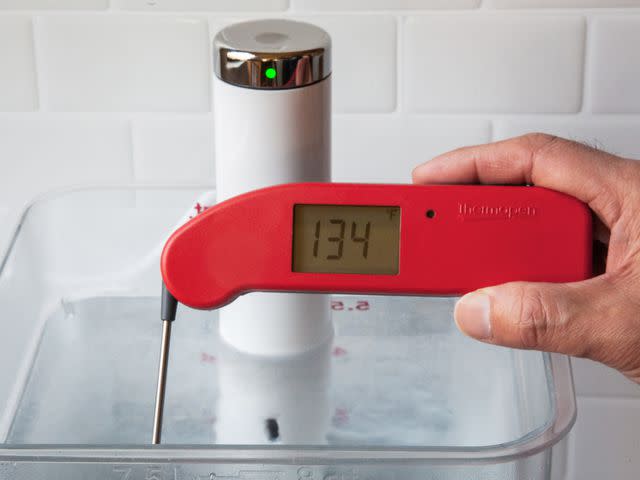
Serious Eats / Irvin Lin
The first thing to decide is if you should buy an instant-read or leave-in probe thermometer. If you don’t own a thermometer or are looking to upgrade an old/inaccurate/sluggish one, go with an instant-read thermometer. You’ll be able to use it for roasting meats, taking the temperature of fry oil, and making sure grilled chicken is, indeed, cooked. Its slim profile easily fits in an apron’s pocket and it’s a breeze to store.
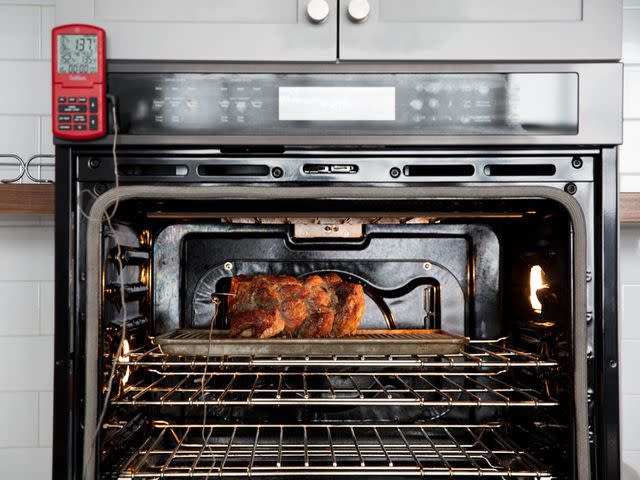
Serious Eats / Vicky Wasik
A leave-in probe thermometer has a long probe that’s connected to a heat-resistant cable, which is attached to a unit that displays the temperature and time. You’re able to stick the probe into, say, a roast chicken and know what temperature the chicken is at any given moment. You can set alarms, too, to let you know when something’s hit temperature or if the temperature dropped too low or high (such as when deep-frying). It’s an extremely helpful tool we think most cooks would also be glad to have on hand.
Accuracy and Speed
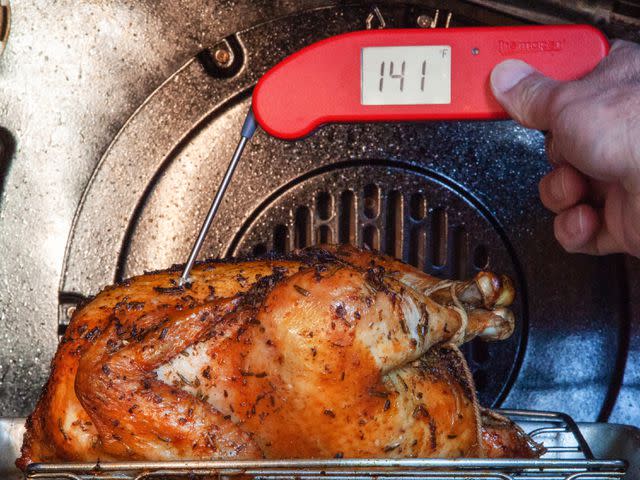
Serious Eats / Irvin Lin
No matter the thermometer you select, it’s gotta be accurate and fast. When we tested instant-read thermometers, we evaluated this by setting a water bath to 134°F using a sous vide machine (that way the bath was the same temperature, no matter where we stuck the thermometer). We also did tests with boiling and ice water. Our favorite thermometers had response times of two to four seconds, on average, and were pretty much dead accurate. Other thermometers were off two to three degrees and took up to 20 seconds to deliver readings.
Read More: We Tested 18 Instant-Read Thermometers–Here Are Our Favorite Models
When we evaluated leave-in probe thermometers, our favorites were all accurate, but all slower than an instant-read thermometer. The fastest, the ChefAlarm, took about five seconds compared to a Thermapen’s two seconds to achieve the same reading. The FireBoard, on the other hand, needed 40 seconds. For barbecuing/grilling, this is fine—but stick to faster thermometers for temperature-sensitive stuff, like making caramel.
Usability and Features
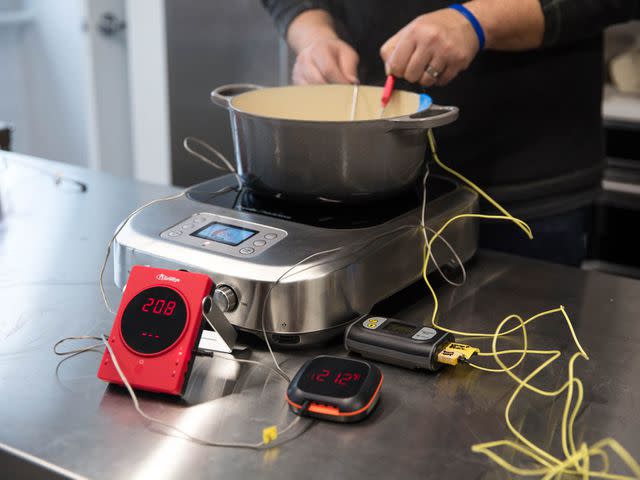
Serious Eats / Vicky Wasik
With instant-read thermometers, we looked for features like a large screen with clear numbers, an auto-rotating screen (so you can read it at any orientation), and an auto backlight (for easy reading in dark spaces, like cavernous ovens and grills).
For leave-in probe thermometers, we wanted longer probes (at least five inches), which made it easier to take the temperature of roasts and to reach into deep pots, such as when deep-frying. We also looked for a large LCD display, appreciated if the whole thing was magnetic (nice for wall ovens), and wanted alarms that could be silenced with the press of a button (no smashing things in while something beeps, beeps, beeps).
What’s the Best Thermometer for Grilling?
A sub-category of leave-in probe thermometers are ones made for grilling, like the ThermoWorks Smoke Remote BBQ Alarm Thermometer. These sort of thermometers are built similarly (long probe, heat-resistant cable), but, ideally, allow you to monitor food remotely for low-and-slow barbecuing. The Smoke has a wireless radio receiver, while the FireBoard is app-compatible. Of course, these thermometers can also be used indoors.
The Criteria: What to Look for in a Meat Thermometer
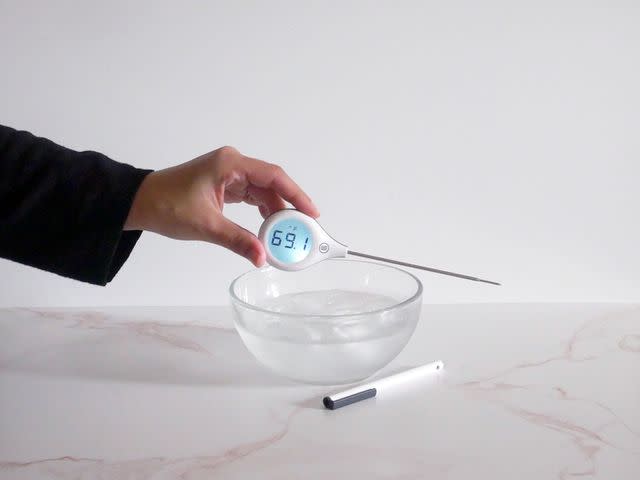
Serious Eats / Grace Kelly
A good meat thermometer should be fast and accurate. It should also have a range of useful features, like an easily readable screen and backlight. If a leave-in probe thermometer’s what you’re after, the probe should be long, the alarm should be able to be silenced with one button, and the whole thing should be, ideally, magnetic. For remote-capable probe thermometers—for low-and-slow barbecuing, for example—the remote receiver/app should be reliable and capable of delivering readings through walls, across a yard, etc.
The Best Meat Thermometer: ThermoWorks Thermapen ONE

Buy at Shop.kingarthurbaking.com
What we liked: With blisteringly fast response times and incredibly accurate readings, the Thermapen ONE was our top instant-read thermometer, besting 17 other models. It’s named the ONE after its reported one-second response time (and in our testing, it was nearly as fast as its namesake). The pull-out probe, large, 360-degree auto-rotating screen, and auto-backlight make it a standout. It also automatically turns on and off when you pull out/push back in the probe and when you pick it up after the thermometer’s been left idle.
What we didn’t like: The numbers on the screen could use a little more contrast, which would make them stand out more.
Price at time of publish: $100.
Key Specs
Temperature range: -58.0 to 572.0°F
Warranty: 5 years
Features: Auto-rotating screen; auto-backlight; auto-on/off; adjustable sleep mode
Good to know: Available in 10 colors
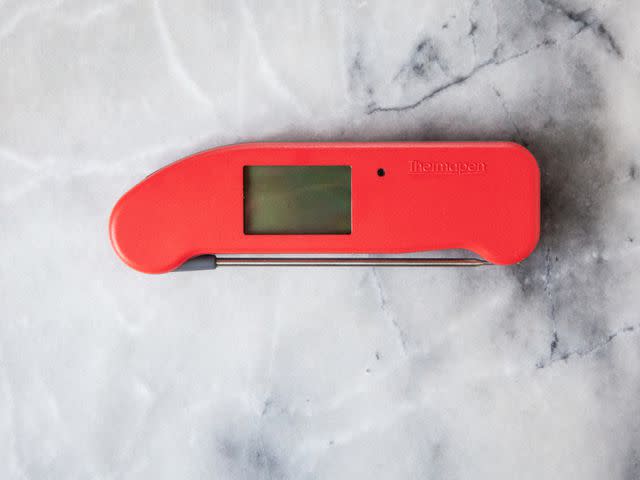
Serious Eats / Irvin Lin
The Best Budget-Friendly Meat Thermometer: Thermoworks ThermoPop 2

What we liked: ThermoWorks rather recently replaced the ThermoPop with the ThermoPop 2—and we’re really happy about the changes they made. It has an auto-rotating screen that’s much bigger and brighter than the original. Its slim profile, cap that hooks onto an apron or chef’s coat, and affordable price point makes it a no-brainer recommendation. It’s nearly as fast and accurate as the Thermapen ONE, too.
What we didn’t like: A very small thing is that the power button is now located at the back of the thermometer, whereas the original ThermoPop had it at the front. We like this new streamlined look, but it might take a small adjustment for those upgrading from the ThermoPop. An additional small quibble is that it takes a few seconds of holding the power button for the thermometer to power off (it’ll shut off by itself after 10 minutes).
Price at time of publish: $35.
Key Specs
Temperature range: -58.0 to 572.0°F
Warranty: 2 years
Features: Auto-rotating screen; auto-backlight; sleep mode after 10 minutes
Good to know: Available in nine colors; you can choose between a 4.5- and 8-inch probe (we recommend the 4.5-inch for most home cooks)
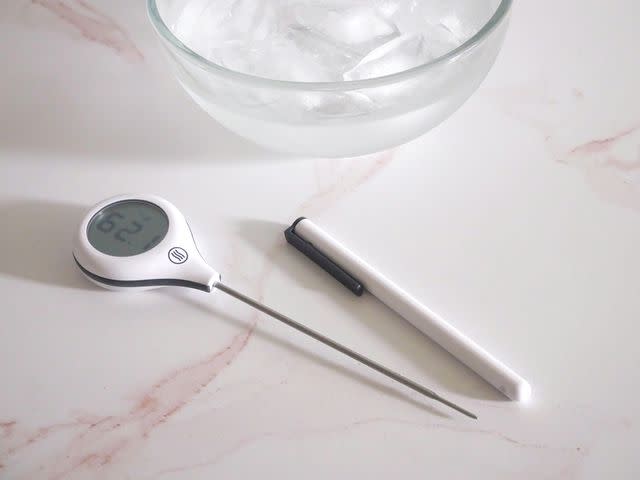
Serious Eats / Grace Kelly
The Best Meat Thermometer for Roasts: ThermoWorks ChefAlarm

What we liked: Its accuracy, responsiveness, large, well-organized screen, and clearly labeled buttons made the ChefAlarm our top leave-in probe thermometer pick. It has a magnetic base that allows it to rest flat or stick on an oven or fridge and a screen that tilts up at a 45-degree angle for easy viewing. The ChefAlarm allows you to set high/low temperature alarms and includes a timer function. It also has a large temperature probe and comes with a pot clip and storage case.
What we didn’t like: As we noted in our review, “The base does not come programmed with meat doneness temperatures (although this isn't entirely bad, since a lot of commonly held temperature recommendations aren’t what we’d suggest, such as cooking chicken to 165°F).” In my experience, the probe’s wire can kink and be a little hard to wrap up and stuff into its storage case.
Price at time of publish: $65.
Key Specs
Temperature range: -58.0 to 572.0°F
Warranty: 2 years
Features: Countdown/up timer
Good to know: Available in nine colors
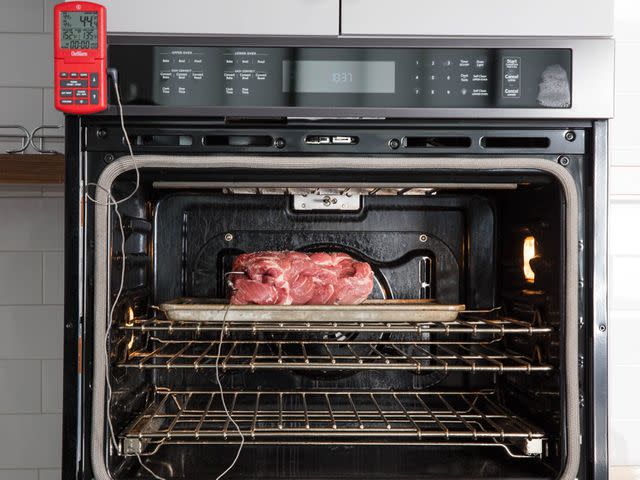
Serious Eats / Vicky Wasik
The Best Budget-Friendly Meat Thermometer for Roasts: Polder Digital In-Oven Thermometer

What we liked: Small and light, and accurate and precise enough for most home cooks, the Polder is our budget-friendly leave-in probe thermometer recommendation. It has a few buttons, but its interface is well-organized and the screen is adjustable. It comes with a pot clip and its cord is silicone-coated, which makes it easy to wrap up and prevents kinking.
What we didn’t like: The power button is on the underside of the base and the cord has a heat-safe temperature of 450°F, which means it’d still be fine for a roast chicken, but not high-temperature grilling.
Price at time of publish: $17.
Key Specs
Temperature range: 32 to 392°F
Warranty: One-year limited warranty
Features: It has a 24-hour countdown timer
Good to know: Extra temperature probes can be purchased here
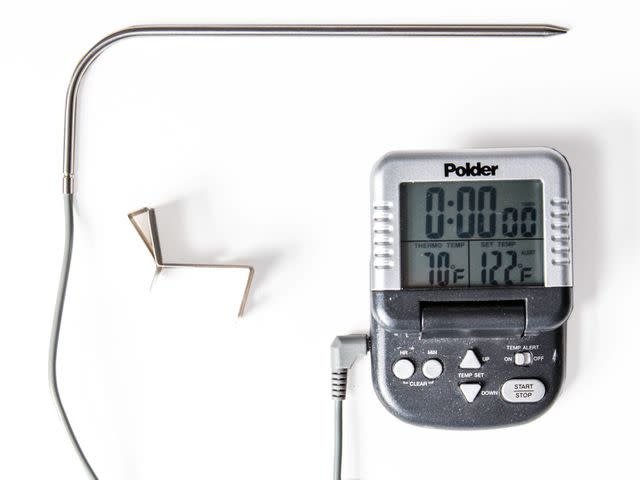
Serious Eats / Vicky Wasik
The Best Meat Thermometer for Grilling: ThermoWorks Smoke Remote BBQ Alarm Thermometer

What we liked: Like other ThermoWorks thermometers, the Smoke is accurate, reliable, and fast. It has a clear interface and has a cooking probe in “the same style and quality as the one used in the ChefAlarm, and it comes with an ambient probe and clip (the clip works well on grill and smoker grates, and can be modified to work in an oven),” as we said in our original review. The Smoke comes with a wireless receiver that allows you to monitor the temperature remotely. You can purchase additional probes for just $19 a pop, which is nice if you’re barbecuing two pork butts at once.
What we didn’t like: The power button has a less intuitive placement at the back of the thermometer. Our tester noted that, “Strong magnets give a thermometer base a good hold, but the Smoke’s are bordering on overkill (it’s a superglue-like hold).”
Price at time of publish: $99.
Key Specs
Temperature range: -58.0 to 572.0°F
Warranty: 2 years
Features: 300-feet line of sight wireless transmission range
Good to know: Available in nine colors; additional probes can be purchased here
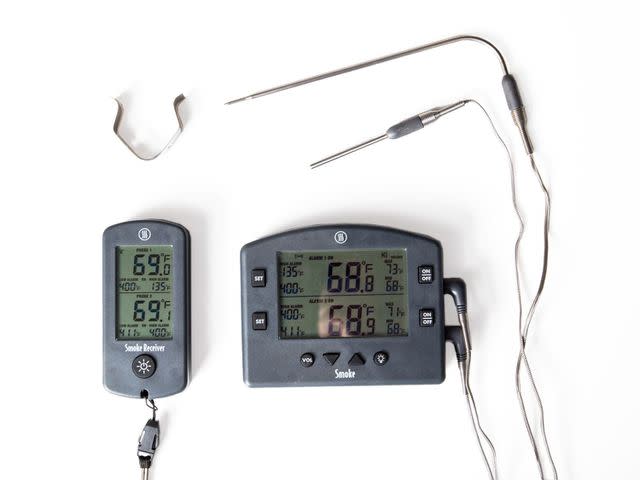
Serious Eats / Vicky Wasik
The Best Meat Thermometer for Serious Grillers: FireBoard FBX2 Leave-In Probe Thermometer for Grilling

What we liked: The FireBoard can handle up to six probes, which makes it our pick for serious grillers who are looking to temp multiple things at once. The FireBoard’s app lets you name each probe, for easy tracking, and has a data-logging feature. This “lets you name each of the probes and keeps track of the time and temperature of your cooks, so you can learn what works and what doesn’t,” we noted in our original review. Of course, it was accurate, too.
What we didn’t like: As with all of the Bluetooth and WiFi-enabled models we tested, the pairing could be fussy at times. It’s pretty pricey.
Price at time of publish: $189.
Key Specs
Temperature range: Up to 1400°F
Warranty: 1-year
Features: App-compatible
Good to know: Additional probes can be purchased here
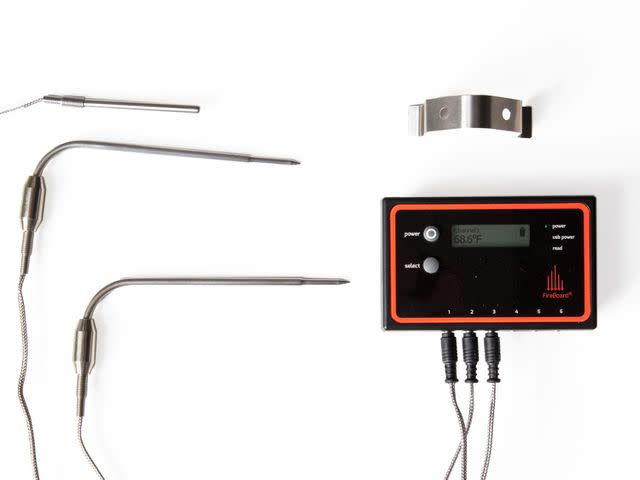
Serious Eats / Vicky Wasik
FAQs
How do you use a meat thermometer?
To use a meat thermometer, you turn the thermometer on (if it doesn’t automatically do so), stick the probe in the meat, and give it a few seconds (or less) to read. That’s it!
How do you calibrate a meat thermometer?
Some meat thermometers will have a dial or button for calibration (some cheaper models can’t be recalibrated, though). For calibrating a ThermoWorks thermometer, the company has an easy to follow, step-by-step calibration guide that can be found here.
How do you read a meat thermometer?
Assuming you’re talking about digital thermometers, the temperature should be handily displayed on the screen. We don’t recommend analog thermometers because they’re harder to read, slower, and less accurate.
Can you use a meat thermometer for candy?
You absolutely can! Leave-in probe thermometers are particularly nice for candy, as they have a pot clip and can monitor the temperature throughout the whole process. You can even set temperature alerts.
Can you use a meat thermometer for oil?
Yes, you can use a meat thermometer for oil. An instant-read thermometer will allow you to spot-check the temperature of oil, while a leave-in probe thermometer will monitor the oil temperature the entire time once it’s set up and positioned with its included pot clip.
Can you leave a meat thermometer in the oven?
Leave-in probe thermometers can be left in the oven to monitor the temperature of roasts (the device should, of course, be stationed outside of the oven). Instant-read thermometers, on the other hand, should not be left in the oven.
Read More: The Best Thermometers for Deep Frying, Candy-Making, and Roasting Meats

